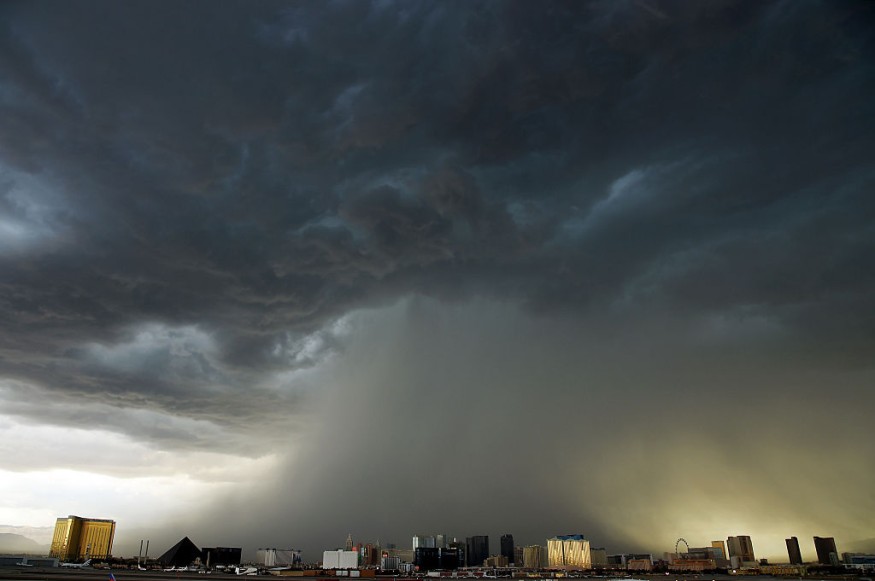Meteorologists predict that a wave of moisture will arrive in the southwestern United States later this week, triggering the start of the North American monsoon.

Kicking Off the Monsoon
A tropical breeze will help kick off the yearly phenomenon that brings more rains and thunderstorms to the Southwest. Starting Thursday and Friday in areas of New Mexico, the change in wind direction from dry West to northwest winds to a moist southerly flow will allow the first scattered showers and thunderstorms to emerge in the pattern. Over the weekend and into early next week, the storms will move westward into parts of Arizona and northward into parts of Colorado and Utah.
This year's monsoon will begin earlier than usual, as AccuWeather's long-range prediction experts predicted in the summer forecast for the United States in 2022.
According to the National Weather Service, the North American monsoon typically begins on July 3 in southern New Mexico and Arizona. The monsoon season, on the other hand, is similar to different rainy seasons and periods of the year.
From June 15 through September 30, the monsoon season begins. The monsoon started last year around the week of June 15 but subsequently faded as the weather became hot and dry from late June to early July. Due to a protracted region of high pressure blocking moisture from migrating northward into the Southwest in 2020, the monsoon was almost non-existent.
"The earliest storms may struggle to produce much rain since the atmosphere will be transitioning from dry to moist very gradually," AccuWeather Lead Long-Range Meteorologist Paul Pastelok said. "In reality, many early storms may deliver little or no rain, but instead strong winds and lightning strikes that might start wildfires and whip up dust from location to spot."
The monsoon pattern may become moist as it develops, resulting in good rainfall for specific locations in the following weeks. Forecasters warn, however, that severe storms and isolated flooding are possible.
Only a few days ago, the Southwest experienced some of the warmest heat the region has seen this year. Death Valley, California, achieved 123 degrees on Friday, June 10, while Phoenix got 113 degrees on Friday and 114 degrees on Saturday.
Weather Patterns
According to AccuWeather Senior Storm Warning Meteorologist Joe Bauer, an intense southerly dip in the jet stream will bring chilly air to the Pacific coast this weekend before lifting northward.
"This jet stream motion, when paired with high pressure that pushes moisture northward, could set the environment for thunderstorms with severe winds, hail, and isolated tornadoes over sections of the interior West this weekend to early next week," Bauer said.
"Some locations in the Four Corners region may face floods," Bauer warned, "particularly in areas with recent fire scars." In certain places, mudslides and debris flows are possible.
"There's a risk that monsoon-related downpours reach northwestern Wyoming and southern Montana," Pastelok said, "but the storms shouldn't be broad enough to dramatically worsen floods that formed in Yellowstone National Park earlier this week." Flash flooding was caused by rain from a storm that arrived from the Pacific Ocean, which swept away bridges and led officials to close the park. Before the resumption of downpours, several days of dry weather or minimal shower activity are expected, which may be enough to allow streams to recede.
Due to the significant and long-term drought in the region, any downpours would be exceedingly beneficial, as long as they did not result in major floods, meteorologists warn. According to the United States Drought Monitor, every state in the West was experiencing some degree of drought. As of Tuesday, all states, except for Washington, have vast regions of severe to extreme and exceptional drought.
Tropical Moisture
For a time next week, some tropical moisture around the coasts of Central America and southern Mexico may be driven northward. However, moisture and thunderstorms associated with the monsoon may retreat southward later in June, similar to last year.
"A large number of monsoon-related showers and thunderstorms are expected for the inner West this summer," Pastelok added. "However, it is not expected to be as rainy as last year."
Tucson, Arizona, experienced more than double its usual amount of rain from June to September 2021, with 12.79 inches. Phoenix had 4.20 inches of rain, compared to a normal of 2.43 inches, while Las Vegas received only 0.65 inches of rain. During the four months, the average rainfall in Sin City is merely 1.06 inches.
"The overall weather pattern is extremely similar to that of 2012, which was the basis for many of our summer projections," Pastelok added. "The timing of high heat and derecho activity in the Central states is comparable to ten years ago."
Related Article : Exposure to Major Disasters Can Cause Long-Term Mental Health Problems
For more climate and weather updates, don't forget to follow Nature World News!
© 2025 NatureWorldNews.com All rights reserved. Do not reproduce without permission.





